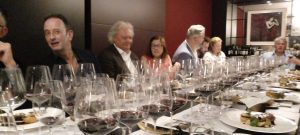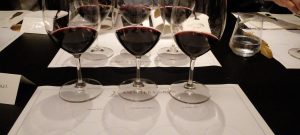The Elegance of Chateau Angelus: A Legacy of Terroir and Innovation
In the heart of the storied St. Emilion appellation lies a venerable institution that has, over centuries, woven its own narrative into the rich tapestry of Bordeaux’s wine heritage. Chateau Angelus, one of the oldest wineries in this hallowed region, epitomizes an enduring commitment to viticulture and oenology. At the heart of this timeless journey is the de Bouard family, whose lineage traces its roots to as far back as 1544, embedded in the very soul of Bordeaux.
The tale of Chateau Angelus begins with a history that extends beyond the horizons of time. In 1626, the de Bouard family ventured into the enchanting landscapes of the Dordogne, where they carved their legacy through land acquisitions and a passion for the vine. It wasn’t until 1910, however, that they cast their gaze upon the serene terroir of St. Emilion, and it was this fateful year that marked the genesis of the Chateau Angelus we revere today.
The lineage of Chateau Angelus intertwines with that of Chateau Mazerat, which the Souffrain family had held in their custodianship since the 18th century. In 1922, the estate transitioned into the hands of Maurice de Bouard de La Forest, who brought forth the vision that would culminate in Chateau Angelus. The fusion of destiny and love emerged when Elisabeth Bouchet, Maurice de Bouard de La Forest’s second wife, acquired the 3.5-hectare Clos L’Angelus vineyard parcel, further enriching the legacy.
The acquisition of prime grape properties became a hallmark of Chateau Angelus’s journey. An additional 13 hectares, nestled in the arms of neighboring estates and acquired from the Gruchy family, solidified Clos de L’Angelus as a substantial vineyard. The vineyard’s mosaic expanded with the inclusion of a second 3-hectare plot, which would later assume the name Chateau Beau-Sejour Becot.
The nomenclature “Chateau Angelus” resonates with simplicity and yet carries a profound tale. It finds its inspiration in the harmonious echoes of the bells ringing from three nearby churches, an everyday serenade to the diligent souls tending to the vineyard. The essence of this name extends to the emblematic logo and the sculpture it evokes, a symphony of artistry and heritage, nestled within the estate’s verdant embrace.
As we navigate the wine-rich annals of Chateau Angelus, we find the de Bouard family still at the helm, steering this venerable ship towards the pinnacle of excellence. Since 1989, Chateau Angelus has emerged as a luminary in the realm of the Right Bank, a testament to their unwavering commitment to quality and innovation.
Notably, it was Hubert de Bouard who would catalyze a transformation in the winemaking practices of the estate. He championed the open-top vat fermentation and the embrace of malolactic fermentation in small barrels. Innovations that emanated from his vision included parcel-by-parcel harvesting, lees aging, whole-berry fermentation, and vinification. These innovations breathed new life into Chateau Angelus, propelling it to the forefront of Bordeaux’s vintners.
Hubert de Bouard did not stop at redefining winemaking techniques. He embarked on a journey to optimize the estate’s potential. Yields were reduced, leaf canopies were raised, green harvesting was introduced, and rigorous selection processes were established. The aging process underwent a transformation, as wines rested in brand-new French oak barrels. Vineyard density increased, and lower-yielding rootstocks found their place in the soil. Drainage systems were refined, setting the stage for a revolutionary chapter in Chateau Angelus’s history.
These innovations, which are now embraced by vineyards worldwide, were once groundbreaking, pushing the boundaries of traditional Bordeaux winemaking. The grapes were harvested later, seeking phenolic maturity, a philosophy that harks back to the Bordeaux winemaking practices of the 1950s, infused with a contemporary twist.
In 2012, Stephanie de Bouard-Rivoal, Hubert de Bouard’s daughter, assumed the mantle of executive manager of the estate. It was a year of profound significance, as Chateau Angelus ascended to the echelons of Premier Grand Cru Classe A in the official 2012 St. Emilion Classification. A distinction shared with only three other St. Emilion estates, it marked a historic moment in the annals of this storied chateau.
To commemorate this momentous achievement, the 2012 vintage of Chateau Angelus was presented in a distinctive, pitch-black bottle adorned with a script of 21.7-carat gold. A departure from their customary label, this design was a fitting tribute to their newfound status.
The transformation at Chateau Angelus was not limited to the winemaking alone. Renowned architects Jean-Pierre Errath and Arnaud Boulain undertook an ambitious project that saw the creation of modernized cellars, a guest receiving area, enhancements to the chateau, commercial offices, and the iconic Chateau Angelus Belltower. The illustrious Frontenac quarries in St. Emilion provided the limestone blocks that laid the foundation for this visionary undertaking. Estimates suggest an investment exceeding 10 million euros to bring this vision to life, with the bulk of the work being completed in time for the 2013 harvest.
Early in 2014, the restoration of Chateau Angelus reached its culmination, a testament to the chateau’s commitment to heritage and modernity seamlessly intertwined.
In a moment that evoked curiosity and contemplation, akin to the finest wines themselves, Stephanie de Bouard, in January 2022, announced that Chateau Angelus would depart from the Classification, following in the footsteps of Chateau Cheval Blanc and Chateau Ausone. The winds of change whispered, and Chateau Angelus decided to part ways with the Premier Cru Classe A designation on its label, starting from the 2022 vintage.
To truly appreciate Chateau Angelus, one must delve into the very terroir that nurtures its noble grapes. The 42-hectare vineyard comprises 50% Merlot, 47% Cabernet Franc, and a graceful 3% Cabernet Sauvignon. This symphony of varietals reflects an evolving blend that highlights the increasing prominence of Cabernet Franc in both the vineyard and the final cuvee.
The choice of terroir for each grape varietal is a deliberate act of precision. Cabernet Franc finds its roots in terroir rich with gravel, limestone, and sand, each layer contributing to its elegant character. Meanwhile, Merlot, with its inherent depth, calls soils with clay and limestone its home. Chateau Angelus, ever the pioneer, was one of the earliest proponents of Cabernet Franc in Saint Emilion, a decision made not in pursuit of improved quality but as an act of devotion to the vine.
The age of the vines, on average, is approximately 38 years, bearing witness to a history etched into the very soul of the vineyard. At Chateau Angelus, the terroir rises and falls like a poetic cadence. The vines that ascend the hills encounter more clay and limestone, standing shoulder to shoulder with their esteemed neighbors, Beau-Sejour Becot and Beausejour Duffau. These sun-kissed vines, open to the south, capture the essence of their enviable terroir.
The journey takes a turn as one descends the slopes, unveiling a tapestry of sand and clay beneath. Yet, the richness of the subsoil, brimming with clay, sustains the Cabernet Franc in its depths, offering a lifeline in the face of hot, dry vintages.
It is crucial to note that only 27 of the 39 hectares of vineyards at Chateau Angelus bear the esteemed designation of First Growths. Thus, Chateau Angelus, the epitome of meticulous craftsmanship, is conceived from this select 27 hectares, forging a legacy that radiates excellence. The remaining 12 hectares give rise to Le Carillon de l’Angelus and No 3, each a testament to the estate’s commitment to quality, regardless of the cuvee.
The vineyard itself is a mosaic of 54 distinct lots, a diverse tapestry that tells a tale of the land. Three unique soil types underpin the vines: clay with limestone, clay with sand, and limestone soil grace the sloping hillsides, while the bottom slopes reveal a mingling of sand and clay. The ancient vines, some dating back to 1918, infuse the vineyard with history and character, with Merlot vines bearing the distinction of being the oldest.
Vine density, a critical component of vineyard management, ranges from 6,500 to 8,000 plants per hectare, reflecting a thoughtful approach to viticulture. In the nascent vineyards, density surges even higher, as Hubert de Bouard understood the vital role it played in crafting wines of unparalleled distinction.
A chapter of distinction unfolded with the 2009 vintage when Hubert de Bouard introduced a manual destemming process. Sixty skilled hands meticulously removed the stems from each grape, a labor-intensive technique that he believed preserved the berries’ freshness and shielded them from the detrimental effects of oxygen. This method was employed for 20% of the crop in 2009, a commitment to craftsmanship that continued with 150 individuals meticulously destemming the grapes in 2010.
In the vineyard and in the cellars, Chateau Angelus has carved a path defined by precision, innovation, and the unwavering pursuit of excellence. It is a journey that intertwines terroir, tradition, and modernity, producing wines that stand as a testament to the enduring legacy of one of Bordeaux’s most illustrious estates. In each glass of Chateau Angelus, one encounters the harmonious blend of history, innovation, and the timeless spirit of the de Bouard family.

The Wines
